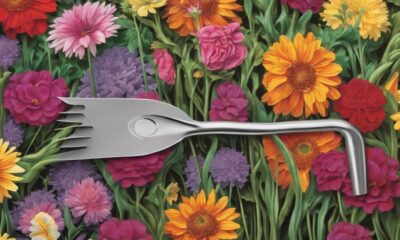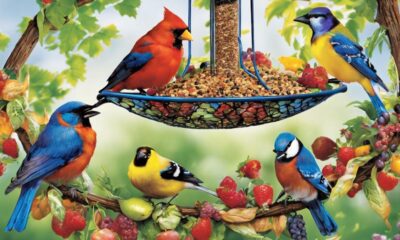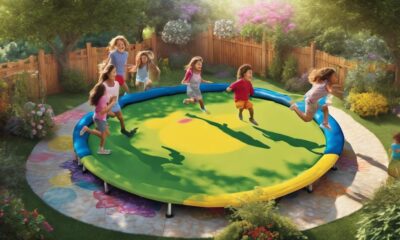Plants
Bleeding Heart Plant Care & Growth Guide
2025
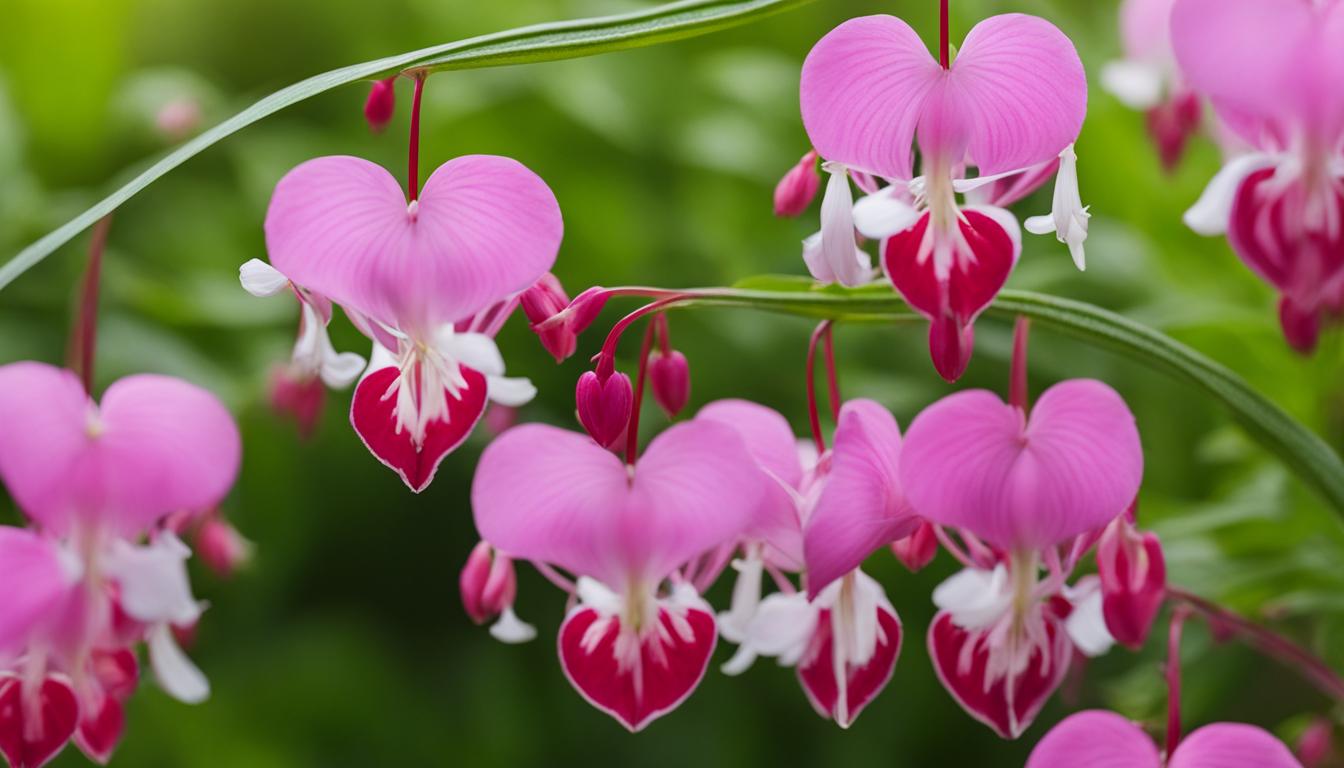
Welcome to our comprehensive guide on bleeding heart plants! In this article, we will provide you with all the information you need to know about caring for and growing these beautiful and meaningful flowers. From understanding the various varieties and their characteristics to learning how to propagate and maintain bleeding heart plants, we’ve got you covered. So, let’s dive in and discover the wonders of the bleeding heart plant!
Key Takeaways:
- Learn how to care for bleeding heart plants and provide the ideal growing conditions.
- Discover the different varieties of bleeding heart plants and their unique characteristics.
- Explore various methods of propagating bleeding heart plants and creating new ones.
- Find out how to successfully grow bleeding heart plants in containers.
- Get tips on pruning, maintaining, and overwintering bleeding heart plants.
Bleeding Heart Plant Characteristics
The bleeding heart plant, a member of the Papaveraceae family, is a beautiful herbaceous perennial known for its distinct characteristics. This shade-loving plant produces elegant heart-shaped flowers on long, arching stems, giving it the common name “bleeding heart.” Each stem typically blooms with around 20 small flowers, which add a touch of grace and charm to any garden.
During the hot midsummer months, the bleeding heart plant’s foliage depreciates and enters a period of dormancy. This natural cycle allows the plant to conserve energy and prepare for the upcoming season. It prefers partial shade but can also tolerate full shade conditions, making it a versatile choice for various garden settings.
Bleeding heart plants thrive in moist, well-draining soil with a slightly acidic to neutral pH. They require adequate moisture to support healthy growth and should not be allowed to dry out completely. These plants can be found in a range of colors, including delicate shades of pink, pristine white, and vibrant red. Their versatility allows them to complement a variety of garden styles and color schemes.
The bleeding heart plant is native to Asia and is hardy in USDA zones 3 to 9. Its ability to withstand diverse climates makes it an ideal choice for gardeners across the United States. Whether planted as a standalone feature or incorporated into a mixed planting scheme, the bleeding heart plant is sure to add beauty and elegance to any landscape.
We must protect the bleeding heart plant, as it is a cherished perennial with its unique characteristics and vibrant blooms. Let’s explore more about caring for and propagating this enchanting plant in the following sections.
Bleeding Heart Plant Care Tips
Once you have established your bleeding heart plants in the garden, caring for them is relatively easy. These perennials have a bit of drought tolerance and are not overly prone to pests and diseases. However, they do prefer moist soil for optimal growth. Let’s dive into some essential care tips for your bleeding heart plants.
1. Soil and Watering
The bleeding heart plant is a perennial that thrives in well-draining soil with a slightly acidic to neutral pH. It prefers moist soil but can handle a bit of drying out between waterings. To keep the soil consistently moist, consider adding a layer of leaf mold as a top dressing. This helps retain moisture while providing natural nutrients to the plant.
2. Light Requirements
Bleeding heart plants are known for their love of partial shade. They can handle full shade but may go dormant early if exposed to direct sunlight for extended periods. Providing some sun protection, such as a windbreak or planting them under the shade of larger plants, can help them thrive.
3. Maintenance
Bleeding heart plants are perennial and can self-seed, allowing them to live indefinitely in your garden. They do not require heavy feeding and are tolerant of normal garden soils. Regular watering, especially during the growing season, is essential to keep their roots hydrated. Prune off any brown or unsightly foliage prior to dormancy to maintain the plant’s appearance. Deadheading spent blooms can be optional, as it allows the plant to self-seed and produce new plants.
Stay tuned for the next section where we explore the different varieties of bleeding heart plants available.
Bleeding Heart Varieties
There are several bleeding heart varieties available, each with its own unique characteristics. These varieties can add different colors and aesthetics to a garden, allowing for more diversity in the bleeding heart plant collection.
Some popular bleeding heart varieties include:
| Variety | Characteristics |
|---|---|
| Lamprocapnos spectabilis ‘Alba’ | Pure white flowers |
| Lamprocapnos spectabilis ‘Gold Heart’ | Yellow-gold foliage and pink flowers |
| Lamprocapnos spectabilis ‘Valentine’ | Bright cherry-red blooms and burgundy stems |
These are just a few examples of the bleeding heart varieties available. By choosing different varieties, you can create a stunning display of color and texture in your garden.
Propagating Bleeding Heart Plants
If you want to expand your collection of beautiful bleeding heart plants, there are several propagation methods available to you. By using division, seed, or stem cuttings, you can create new plants and rejuvenate older ones. Let’s explore each method in more detail:
1. Division
Division is a simple and effective way to propagate bleeding heart plants. It is best done after flowering when the plant is dormant. Here’s how you can do it:
- Carefully dig up the plant, making sure to preserve the root clumps.
- Gently separate the root clumps into smaller sections, ensuring that each division has enough roots and foliage.
- Replant the divided sections in new spots in your garden or containers, ensuring they have adequate space to grow.
- Water the newly planted divisions thoroughly and keep the soil lightly moist until they establish new roots.
Different varieties of bleeding heart plants may require different division techniques, so it’s important to research the specific needs of your chosen variety.
2. Seed Propagation
If you prefer starting from seed, you can propagate bleeding heart plants in the fall. Here’s how:
- Collect mature seed pods from your existing bleeding heart plants in the late summer or early fall.
- Gently crush the seed pods to release the seeds.
- Sow the seeds in a tray or individual containers filled with a well-draining potting mix.
- Cover the seeds lightly with soil, ensuring they are not buried too deeply.
- Place the trays or containers in a location that receives bright, indirect light.
- Keep the soil consistently moist but not waterlogged.
- Once the seedlings are large enough to handle, transplant them into larger containers or your garden.
3. Stem Cuttings
Propagating bleeding heart plants from stem cuttings is typically done in spring to early summer when the plant is actively growing. Here’s how you can do it:
- Select a healthy stem from your bleeding heart plant, around 4 to 6 inches long.
- Using a sharp and clean pair of garden shears, cut the stem just below a leaf node.
- Remove the lower leaves from the cutting, leaving a few at the top.
- Dip the cut end of the stem in a rooting hormone powder or gel to encourage root formation.
- Plant the cutting in a container filled with a well-draining potting mix or directly in the garden.
- Keep the soil consistently moist and provide the cutting with partial shade to protect it from direct sunlight.
- Once the cutting develops roots and shows signs of new growth, you can transplant it into a larger container or your garden.
| Bleeding Heart Propagation Methods | Best Time to Propagate |
|---|---|
| Division | After flowering |
| Seed Propagation | Fall |
| Stem Cuttings | Spring to early summer |
Through these propagation methods, you can multiply your beloved bleeding heart plants and share their beauty with others. Whether you choose division, seed propagation, or stem cuttings, each method offers its own unique advantages and rewards. So go ahead and experiment with these techniques to expand your collection of stunning bleeding heart plants!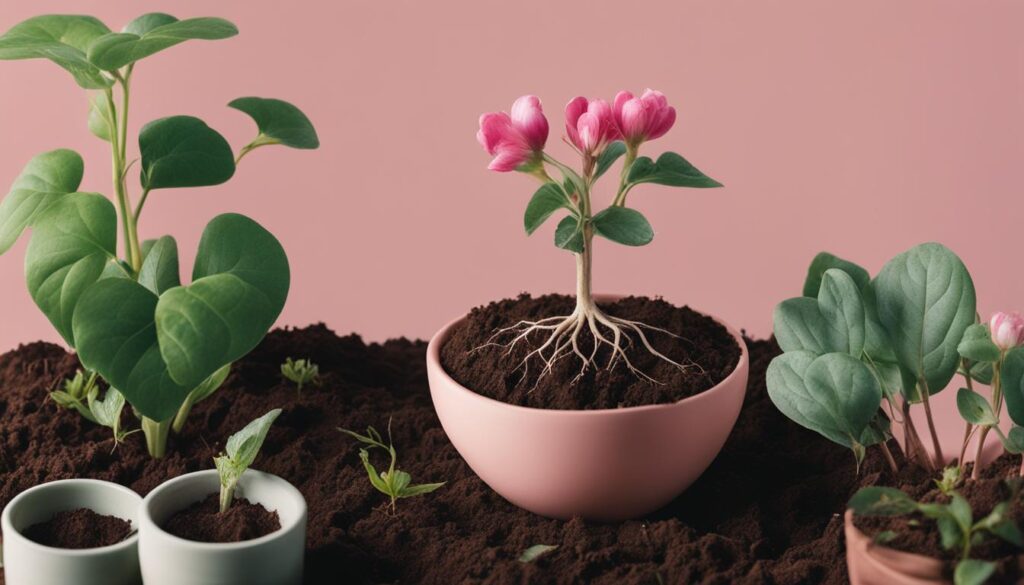
Growing Bleeding Heart in Containers
Growing bleeding heart plants in containers is a fantastic way to add a touch of elegance and beauty to small spaces or urban gardens. Plus, it allows you to easily move the plant around to showcase its stunning flowers wherever you desire within your outdoor living space.
When choosing a container for your bleeding heart plant, opt for one that is at least 12 inches in diameter. This will provide enough space for the plant’s root system to grow and thrive. Additionally, ensure that the container has adequate drainage holes to prevent waterlogging, as excessive moisture can cause root rot.
For optimal growth and drainage, use a well-draining potting mix that contains perlite. This lightweight material helps to improve soil aeration and prevent water from becoming stagnant around the roots. A well-draining mix will keep your bleeding heart plant healthy and happy.
With proper care and maintenance, bleeding heart plants can remain in containers for four to five years before needing to be repotted or divided. This makes them a great option for long-term container gardening.
To ensure the well-being of your bleeding heart plant, it is essential to water it regularly. Keep the soil moist but not waterlogged, as these plants prefer a consistently moist growing environment. Avoid letting the soil dry out completely between waterings.
During the winter months, adding a layer of mulch to the container can help insulate the roots and protect them from the cold temperatures. Mulch acts as a natural insulator, retaining moisture and preventing temperature extremes that can harm the plant.
When growing bleeding heart plants in containers, remember that they still require some shade. Place your container in a location that receives partial shade, ensuring that the plant is protected from direct sunlight during the hottest part of the day. This will help the plant thrive and maintain its vibrant flowers for longer.
Pruning and Maintaining Bleeding Heart Plants
When it comes to bleeding heart care, pruning plays a crucial role in maintaining the health and appearance of these beautiful plants. While bleeding heart plants do not require major pruning, there are a few simple tasks that can help enhance their growth and overall appeal.
One of the first pruning tasks to consider is the removal of brown and unsightly foliage. This is best done prior to dormancy when the plant is starting to fade. By trimming away the discolored leaves, you can tidy up the plant and prepare it for the dormant period.
Tip: Use sharp, sterilized pruning shears to prevent the spread of diseases.
Another type of bleeding heart plant that may require specific pruning is the fringed-leaf variety. These particular bleeding hearts can sometimes become ragged-looking with time. To rejuvenate them, they can be sheared back to their basal growth, which will promote fresh and healthy foliage.
When it comes to deadheading, or removing spent blooms, it is mostly an optional task for bleeding heart plants. While leaving the flowers to go to seed allows bleeding hearts to self-seed and produce new plants, deadheading can help improve the plant’s appearance by preventing it from looking untidy.
Regular watering is crucial for the overall health of bleeding heart plants, especially during the growing season. Adequate hydration helps keep the roots hydrated and prevents the plants from becoming stressed or drying out.
Bleeding heart plants have good tolerance for high humidity. Therefore, it is not necessary to take any special measures to adjust the humidity levels for their optimal growth.
Common Pests and Diseases of Bleeding Heart Plants
When it comes to bleeding heart care, these plants are generally resilient against pests and diseases. However, there are a few common culprits that can still cause problems. The good news is that with proper prevention and treatment, you can keep your bleeding heart plants healthy and thriving.
Pests
Here are some of the pests that can potentially affect bleeding heart plants:
| Pest | Treatment |
|---|---|
| Aphids | Use insecticidal soap or neem oil to treat aphid infestations. |
| Scale | Apply insecticidal soap or neem oil to control scale insects. |
| Slugs and Snails | Physically remove slugs and snails from the plants to control their populations. |
Note: It is important to regularly inspect your bleeding heart plants for signs of pests and take action as soon as you notice any infestations.
Diseases
Bleeding heart plants may also be susceptible to fungal diseases, including powdery mildew and leaf spot. To effectively treat these diseases, consider the following:
- Use fungicides specifically formulated to target powdery mildew and leaf spot.
- If a plant is severely affected, it is best to remove and dispose of it to prevent the spread of the disease to other plants.
Remember to always follow the instructions provided on the pesticide/fungicide labels and take the necessary precautions when applying them to your plants.
Overwintering Bleeding Heart Plants
During the winter season, bleeding heart plants naturally go dormant, and the above-ground parts of the plant may appear dead. However, beneath the surface, the roots usually survive the cold weather, ready to regrow in the spring.
To ensure the health of your bleeding heart plants during the winter, it’s important to take a few steps to protect them.
- Cutting back the stems: Before winter sets in, it’s recommended to cut back the stems of the bleeding heart plant to around 1 or 2 inches from ground level. This helps remove any dead foliage and prepares the plant for dormancy.
- Watering and mulching: Prior to the first frost, water the soil around the plant to provide moisture before the freezing temperatures. After watering, add a layer of mulch on top of the plant stems. Mulch acts as insulation, protecting the roots and helping to retain moisture during the winter.
In the spring, as the ground thaws and temperatures rise, you can remove the mulch from around the bleeding heart plant. This allows the new growth to emerge and the plant to continue its growth cycle.
By following these overwintering tips, you can help ensure the survival and thriving growth of your bleeding heart plants.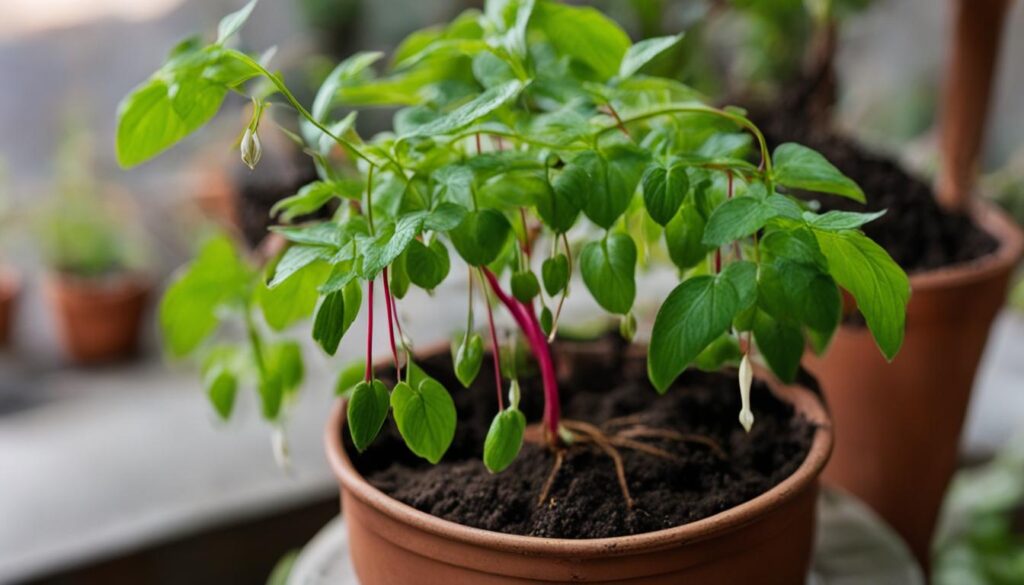
Conclusion
Bleeding heart plants are an enchanting addition to any garden, with their heart-shaped flowers and delicate foliage. Their vibrant blooms and unique growth habits make them a captivating sight that can bring joy and beauty to your outdoor space. Whether you choose to plant them in the ground or grow them in containers, bleeding heart plants are relatively easy to care for and can thrive in partial shade or full shade conditions.
Proper watering and maintenance are key to ensuring the longevity and charm of these perennials. With regular watering and attention to their needs, bleeding heart plants can provide years of stunning beauty in your garden. Their heart-shaped flowers in shades of pink, white, and red are sure to captivate any onlooker.
So, whether you’re a seasoned gardener or a beginner, consider adding bleeding heart plants to your garden. Their enchanting blossoms and delicate foliage will bring a touch of magic and elegance to your outdoor space. With a little care and attention, these charming perennials will reward you with their timeless beauty, making your garden a truly special place. To care for your bleeding heart plant according to the Ultimate A-Z Plant Names Guide, provide well-drained soil, partial shade, and regular watering in a cool, moist area. Keep an eye out for aphids and slugs. This guide is a must-have for ultimate plant names for gardeners. A bleeding heart plant, scientifically known as Lamprocapnos spectabilis, is a shade-loving perennial that produces puffy, heart-shaped pink flowers on long, arching stems. It gets its name from the white petal that protrudes from the heart shape, resembling a drop of blood. The meaning behind the bleeding heart flower is often associated with unrequited or rejected love. Bleeding heart plants are moderate growers, reaching a height and spread of 1 to 3 feet. Yes, bleeding heart plants are toxic to people and pets, so caution must be taken when planting them. Bleeding heart plants thrive in moist, well-draining soil with a slightly acidic to neutral pH. Yes, bleeding heart plants prefer partial shade but can also tolerate full shade. Bleeding heart plants can be propagated through methods such as division, seed, and stem cuttings. Yes, there are several bleeding heart varieties available, each with its own unique characteristics, including different flower colors. Yes, bleeding heart plants can be grown successfully in containers as long as the conditions are right. Bleeding heart plants do not require major pruning, but removing brown and unsightly foliage prior to dormancy is recommended. Regular watering and deadheading are also important for their care. Common pests that can affect bleeding heart plants include aphids, scale, slugs, and snails. Fungal diseases like powdery mildew and leaf spot can also occur. Bleeding heart plants naturally die back during the winter season, and it is recommended to cut the stems down and protect the roots with mulch.How can I care for my bleeding heart plant according to the Ultimate A-Z Plant Names Guide?
FAQ
What is a bleeding heart plant?
What does the bleeding heart flower symbolize?
How big do bleeding heart plants grow?
Are bleeding heart plants toxic?
What type of soil do bleeding heart plants prefer?
Can bleeding heart plants tolerate full shade?
How do you propagate bleeding heart plants?
Are there different varieties of bleeding heart plants?
Can bleeding heart plants be grown in containers?
How should bleeding heart plants be pruned and maintained?
What are common pests and diseases that affect bleeding heart plants?
How do you overwinter bleeding heart plants?
- About the Author
- Latest Posts
Meet Bethia, the visionary designer at ByRetreat who brings a touch of magic to every remote workspace she creates. With a boundless imagination and an eye for beauty, Bethia is passionate about transforming ordinary spaces into extraordinary havens of creativity and comfort.
Bethia possesses a unique talent for envisioning the perfect combination of furniture, colors, and textures that harmonize seamlessly in a room. She understands that selecting furniture goes beyond mere functionality; it’s about curating pieces that evoke a sense of style and sophistication while enhancing the overall ambiance.
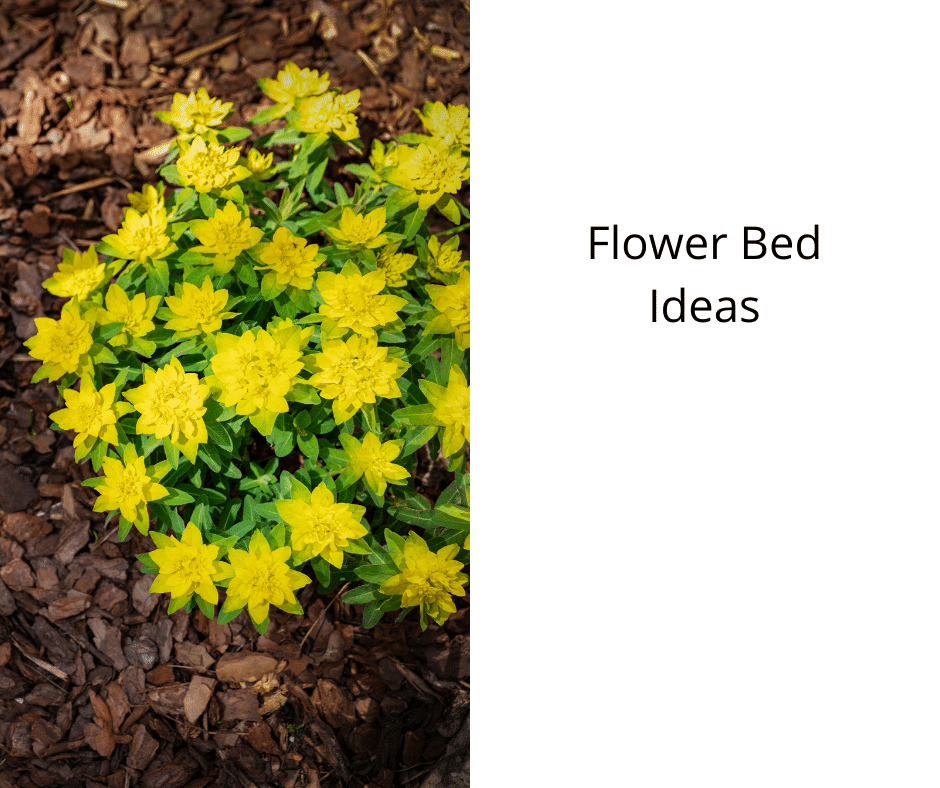
If you want to add a splash of color to your garden bed, there are various methods you can try. From planting tulips in a pot, to adding hydrangeas, succulents, and even a trellis, these ideas are simple to execute and will enhance the beauty of your flower bed.
Planting Tulips in Pots
Planting tulips in pots is a beautiful way to decorate your flower bed. They will last much longer than cut flowers and can be brought indoors to keep your room looking fresh. However, they will die once you cut them. Planting tulips in pots is a great alternative to planting them in the ground, and they look great in window boxes, too.
When planting tulips in pots, it is important to remember that the soil in your pot should have a drainage hole in it. This will help to keep your flowers from drowning in water. You can use Miracle-Gro Potting Mix to fill the pot.

In case your soil is heavy, mix some sand in it to make it lighter. You should then plant your bulbs four to six inches deep. The spacing between each bulb should be 4 inches (10 cm). You can also use bulb planters to make the process easier.
Tulips grow best in full sun. If your flower bed is shaded, plant them under a leafless tree. They are inexpensive and colorful, and blend in well with other spring flowers. Another bonus: tulips are edible! Planting tulips in pots is a great way to add color and interest to your flower bed.
Planting Hydrangeas
Hydrangeas are a great plant to incorporate into your flower bed ideas. They can be grown in large pots and are an eye-catching addition to your outdoor space. Plant them in early spring or fall to give them plenty of time to establish a robust root system. During the first spring, water them well to ensure they are correctly established.
Hydrangeas are an easy plant to grow. They are hardy in zones 3 to 9, and they can grow as large as 15 feet tall. Their flowering season varies depending on the variety, but most will bloom throughout the summer and into fall. The blooming time for hydrangeas varies by variety, but many varieties can tolerate full sun.

Hydrangeas can be pruned to make them look tidy. Pruning them does not require major surgery, but it will enhance their structure and allow them to breathe. You can choose to prune your hydrangeas in late spring or early summer, but keep in mind that pruning is only necessary for plants with a mature flower head.
If you are planting hydrangeas in flower bed ideas, you can buy a one-gallon shrub. This type of plant will have more extensive roots, which means it can establish itself quickly and have a dramatic impact. Alternatively, you can grow hydrangeas from seed. When starting a new plant, make sure that you cover it with a layer of soil and do not bury the seeds.
Planting Succulents
Before planting succulents, you should know about how to prepare the soil. Generally, succulents need at least six inches of specialized soil. You can add sand or organic material to improve drainage. The soil should have adequate space to grow roots and should be moist but not dry. This will help prevent weeds and conserve moisture.
Succulents need regular watering to keep them healthy and to grow well. However, you should make sure that they dry out between waterings, as it gives them breathing space. The frequency of watering will depend on the soil and weather conditions. Some varieties may go for weeks or months without water.
Planting succulents in containers is a great way to add color to any flower bed. They are small enough to fit into a small space and can colonize it quickly. Alternatively, you can plant them in cracks in concrete or brick. Echeverias and sempervivums are hardy plants and can even be planted in concrete.

Planting succulents in a flower bed requires a bit of planning. Start by choosing succulents that are easy to grow and maintain. For beginners, it’s best to go for easy-care, low-maintenance species, such as Sempervivum or Sedum. When arranging your succulents in a flower bed, try to place the tallest species in the center, and the smaller ones on the edges, or between larger plants.
Planting a Trellis
A trellis gives a flower bed a nice architectural touch. It also secures climbing plants and adds privacy. There are many different types of trellises. Some are made of wood, while others are made of metal. The trellis you choose depends on what you want to grow in your flower bed.
A simple trellis can be purchased for a fair price. A more elaborate one can be made with more time and effort. There are many types of trellises available, and you can choose from a number of classic and unusual designs. The classic style is simple but elegant, a square grid that looks perfect when vines cover the trellis. You can make a trellis using the right tools and measurements.

Another type of trellis is a triangular trellis. This trellis is useful for supporting annual vines. Plants that grow up the triangular structure have a tendency to grow horizontally.
Planting Grasses
Grassy flower beds can provide a beautiful backdrop for the flowering plants in your garden. You can plant several different types of grasses to create a variety of textures and colors. Most varieties are annuals, so you will not have to worry about transplanting or dividing them. In addition, few pests bother grasses. Most of them can be controlled with regular watering.
While grasses can be used in various ways, they are best suited for large areas. They can be used in combination with perennials to help define a border or to define spaces within a flower bed. There are even several varieties of grasses that grow in large mats.

Before planting grasses, be sure to choose a shady spot where the sun won’t burn them. Shaded areas can be perfect for Norther sea oats and black mondo. Tall grasses can also be planted in terracotta pots. You should also remove the old growth before planting. This will help new growth thrive in the spring.
Depending on the species, you can plant grasses in your flower beds during spring and autumn. Different grasses have different growing conditions and require different amounts of care. Some prefer moist soil while others prefer dry soil. Most grasses prefer full sun, though some can also tolerate partial shade. Some require periodic cutting and division during the spring.
Planting a Patterned Border
Planting a patterned border in flower bed can add visual interest to your flower bed. You can also mix up colors or plants and place them randomly around the border. It’s important to avoid creating distinct clumps of one color. Instead, use a mix of colors that will make the border more cohesive.
Consider using colorful perennials and annuals. They will brighten the border while also providing long-lasting color and a low cost. A solid-green groundcover will also help you keep the border from looking too busy. You can also use evergreen shrubs for their distinctive plant forms and color.
When planning the design for your border, remember that it’s not a difficult process. You should know the plant habits and flowering times of your chosen plants. You can then decide on a colour theme and fill in the gaps with matching plants as the season progresses.

A border needs periodic maintenance, and it’s important to embrace the fact that your border will change over time. Some species will disappear and others will grow. To keep the design fresh, you can do some minor maintenance in spring and fall. You can also weed the border or lift up rampant plants.
Planting Roses
One of the first steps when planting roses in a flower bed is determining the best spot for them. The best spots for roses are those that receive full sun most of the day. Roses in colder climates should be planted in partial shade during the afternoon. This will prevent blossoms from being scorched and help them last longer. It is important to keep the soil moist and free of weeds. Roses also need good air circulation and well-drained soil.

Roses should be planted in well-prepared soil that is slightly acidic. Soils with a pH of 6.5 are ideal for most roses. You can test the soil’s pH by using a soil test kit. If the soil is too acidic or alkaline, you can add sulfur or finely ground limestone to balance it. When planting bare-root roses, make sure that they are thoroughly wet before planting. The roots should remain moist for eight to 12 hours before planting. Once the roots have been prepared, dig a hole at least two inches deep and twice as wide as the root’s length.
After planting roses, keep an eye out for aphids and other pests. These insects feed on the leaves and flowers of roses. Luckily, most of these pests are easily controlled by neem oil or insecticidal soap. Roses that are susceptible to aphids can be protected by planting alliums around them.
- About the Author
- Latest Posts
Introducing Ron, the home decor aficionado at ByRetreat, whose passion for creating beautiful and inviting spaces is at the heart of his work. With his deep knowledge of home decor and his innate sense of style, Ron brings a wealth of expertise and a keen eye for detail to the ByRetreat team.
Ron’s love for home decor goes beyond aesthetics; he understands that our surroundings play a significant role in our overall well-being and productivity. With this in mind, Ron is dedicated to transforming remote workspaces into havens of comfort, functionality, and beauty.
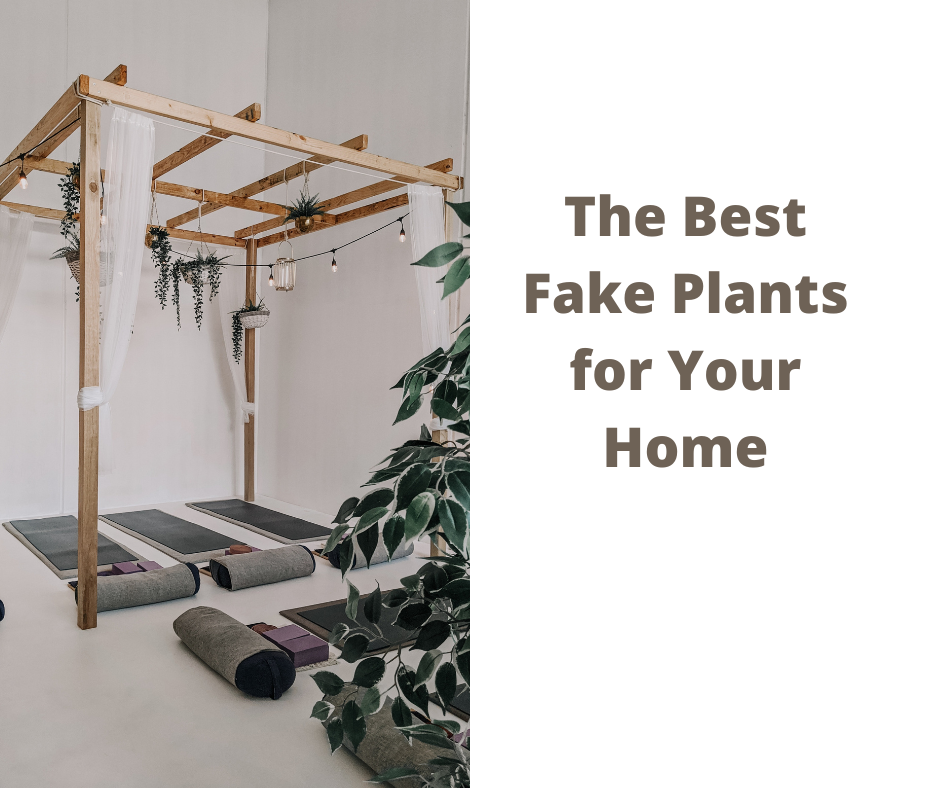
When it comes to bringing greenery into your home, there are two different perspectives. Some individuals insist on using real plants, while others are content with artificial ones. Each approach has its advantages and disadvantages, but if you decide to go with fake plants, it’s important to consider a few factors. Start by selecting a plant that suits the specific area where you intend to place it.
A plant thrives in low-light conditions and will not look very good in a sunny spot. Second, make sure the materials the plant is made from look realistic. Artificial plants made of plastic or silk are often quite obvious, while those made of more natural materials like wood or paper can be much more convincing. Finally, don’t forget to dust and clean your fake plants regularly. A little bit of upkeep will go a long way towards making them look their best.
Best Fake Plants
Are you looking for some new plants to add to your home décor but don’t want the hassle of taking care of them? Check out our list of the best fake plants! These artificial plants look so real that you’ll be surprised at how great they look in your home. Plus, they require no maintenance so that you can enjoy their beauty without fuss.
Fake Plants Are a Great Choice
Nothing like a touch of greenery brightens up a room, but keeping real plants alive can be challenging. Fake plants offer the beauty of the real thing without any hassle, and they’re becoming increasingly realistic. New technologies have made artificial plants look more lifelike than ever before, making them a great option for anyone who wants to add a touch of nature to their home without any work.

Fake plants are also incredibly versatile. They come in a wide range of styles and sizes, so it’s easy to find one that fits your décor. Best of all, they require no watering or maintenance so that you can enjoy them hassle-free. Whether you’re looking for a low-maintenance option or simply can’t keep real plants alive, fake plants are a great choice.
Best Overall – 6ft Artificial Fiddle Leaf Fig Tree (72in)
There’s no doubt about it, fiddle leaf fig trees are beautiful. But for those who don’t have a green thumb, caring for a living plant can be daunting.
[affiliatable id=’99536′] Thankfully, there are plenty of great faux options on the market, and the OXLLXO Artificial Fiddle Leaf Fig Tree is one of the most realistic-looking. The tree features a series of narrow trunks and thin branches dotted with lush leaves. These leaves are soft, and the branches are adjustable, so you can customize the tree to suit your space. Plus, there’s no need to worry about watering or fertilizing—just enjoy your beautiful tree!
Best Budget – Faux Plants Indoor
Updating your décor can be a fun way to refresh your space, but it can also be a costly undertaking. Consider opting for a faux plant if you’re looking for a dramatic update that won’t break the bank. Faux plants have come a long way recently, and many are incredibly realistic.
[affiliatable id=’99547′]
Nearly Natural’s Golden Cane Palm Silk Tree is a prime example. The plant is a whopping 6’6” tall, so it should make a statement in any room. And since its leaves are crafted from delicate silk, they look incredibly realistic. Plus, the tree comes in a stylish planter that will elevate your space. Whether you’re looking to add a touch of nature to your décor or simply want to make a bold statement, this faux plant is up to the task.
Forever Leaf has a great selection of affordable artificial plants if you’re looking for a way to add some green to your space without breaking the bank. Whether you’re looking for a small potted plant to spruce up your desk or a large floor plant to add some life to your living room, Forever Leaf has a wide variety of options.
And unlike real plants, these faux plants require no watering or maintenance so that you can enjoy their beauty without any hassles. So if you’re looking for an easy and budget-friendly way to add some greenery to your space, check out Forever Leaf.
Best Palm – Nearly Natural 6.5ft. Golden Cane Palm Silk Tree
The Nearly Natural 6.5ft. Golden Cane Palm Silk Tree is an elegant addition to any room. The palm tree is known for its ability to thrive in warm climates, and its beautiful golden leaves add a touch of luxury to any setting. The Nearly Natural 6.5ft. Golden Cane Palm Silk Tree is also remarkably easy to care for.
[affiliatable id=’99549′]
The faux tree is a beautiful addition to any home. With three narrow trunks and 333 palm leaves, it is incredibly realistic and easily the most lifelike of all the fake plants of its kind. I found it easy to move from room to room, and loved how it looked in her home. The pot is black, but if you’re looking for something with more flair, you can easily swap it out for something else. The tree weighs only 11 pounds, making it easy to transport. It is also very easy to assemble and looks great in any space. This is the one for you if you’re looking for a beautiful, realistic fake tree.
Unlike real palm trees, it doesn’t require regular pruning or watering, and it can be enjoyed for years with minimal upkeep. Whether you’re looking to add a touch of the tropics to your home or simply want an attractive and low-maintenance plant, the Nearly Natural 6.5ft. Golden Cane Palm Silk Tree is a perfect choice.
Best Monstera – Artificial Monstera Deliciosa Plant 37″
The Best Monstera – Artificial Monstera Deliciosa Plant is a replica of the real thing, down to the smallest detail. It stands 37″ tall and is made from high-quality materials, making it durable and long-lasting.
Monstera plants are a beautiful addition to any corner. This lifelike fake monstera deliciosa plant with superb detailing is the perfect substitute for a real tree because it mimics the natural branches, and foliage of a real thing.
[affiliatable id=’99565′]
To use this artificial tree for interior décor, you don’t have to worry about watering, trimming, or applying fertilizer. This makes it an ideal choice for people who want all the beauty of a real plant without any hassle. Whether you’re looking to add a touch of nature to your home or office, these plants are a perfect way to do it.
Best Orchid: White Realistic Artificial Phalaenopsis Orchids
Orchids are a beautiful, elegant addition to any home. They come in many different colors, but white orchids are particularly stunning. White Realistic Artificial Phalaenopsis Orchids are the best type of artificial orchids because they look real. The petals are made of a soft, silky material that looks just like real orchid petals. They also have realistic-looking leaves and stems.
These orchids come in various sizes to choose the perfect one for your home. You can also find them in different price ranges, depending on how many you want to buy. Whether you’re looking for a single orchid to add to a vase or an entire set to decorate your home, White Realistic Artificial Phalaenopsis Orchids are a perfect choice.
[affiliatable id=’99567′]
Thanks to their beautiful blooms and graceful stature, orchids are among the most popular houseplants. However, they can also be notoriously finicky, requiring precise watering and humidity levels to thrive. If you don’t have the time or patience to care for a real orchid, a faux option like The Faux Orchid Phalaenopsis is a great alternative.
This lifelike artificial plant features intricate details and realistic blooms that will fool even the most discerning eye. Best of all, it’s incredibly low-maintenance, requiring nothing more than an occasional dusting to keep it looking its best. So if you’re looking for an elegant houseplant that won’t require constant attention, The Faux Orchid Phalaenopsis is a perfect choice.
Best Succulents – 16 Pack Artificial Succulent Flocking Plants Unpotted Mini Fake Succulents Plant
If you’re looking for a low-maintenance way to add some greenery to your space, look no further than these artificial succulent plants. These picks are made of a soft, flocked material that looks realistic, yet is easy to care for.
[affiliatable id=’99556′]
Simply insert them into a planter of your choice and enjoy the look of a healthy succulent garden without hassle. These plants are versatile and can be used in various settings, from office cubicles to wedding centerpieces. So whether you’re looking to add a touch of nature to your decor or searching for an easy way to spruce up your space, these artificial succulent plants are the perfect solution.
These artificial succulents worked out great for the wreath I made for a customer. The succulents looked very realistic and I received many compliments from people who saw it. The succulents are usually quite costly, so this was a great deal. I’m picky about these things, but even up close, these looked real.
For a 14″ wreath, I required 2 orders of these succulents and some additional greenery. overall, I was very happy with this product.
Best Hanging Basket – Bougainvillea Hanging Basket Silk Plant
Hanging plants are a great way to add a splash of color to your home without taking up valuable floor space. This hanging basket plant from Nearly Natural is a beautiful option with a rich pink hue. The faux flowers and cascading vines look and feel surprisingly real, thanks to the brand’s horticulturist-approved design. Plus, there’s no need to worry about watering this plant— simply enjoy its fresh look without the hassle.
[affiliatable id=’99570′]
If you’re looking for a cascading bougainvillea that will make a statement, look no further than the Nearly Natural. Bougainvillea Hanging Basket Silk Plant.
This beautiful plant is crafted with South American bougainvillea and features three delicate pastel petals surrounded by a mix of tiny cream-colored flowers. The cascading vines extend gracefully around a traditional wicker planter, and the lush leaves complement the vibrant blooms.
Best Artificial Arrangement – aux Eucalyptus Plants in Rustic Rectangular Wood Planter Box
Looking for a beautiful and realistic faux eucalyptus plant to add to your décor? Look no further than our Faux Eucalyptus Plant in Rustic Rectangular Wood Planter Box! This wonderful arrangement comes with artificial eucalyptus plants in two-tone green color, nestled in a rustic wooden planter box.
The dusty look of the plants makes them appear more realistic, making them a wonderful tabletop decoration or floral centerpiece for any occasion.
[affiliatable id=’99573′]
This Faux Eucalyptus Greenery Arrangement is the perfect way to add a touch of nature to your home or office décor. The artificial leaves and branches are crafted with realistic detail, and the vibrant green color is sure to brighten any space.
The arrangement comes in a black plastic pot, making it easy to display on a table, desk, or shelf. It is a great gift for housewarming, weddings, and Mother’s Day. Whether looking for a beautiful centerpiece for your dining room table or a simple way to spruce up your office décor, this Faux Eucalyptus Greenery Arrangement is a perfect choice.
- About the Author
- Latest Posts
Meet Bethia, the visionary designer at ByRetreat who brings a touch of magic to every remote workspace she creates. With a boundless imagination and an eye for beauty, Bethia is passionate about transforming ordinary spaces into extraordinary havens of creativity and comfort.
Bethia possesses a unique talent for envisioning the perfect combination of furniture, colors, and textures that harmonize seamlessly in a room. She understands that selecting furniture goes beyond mere functionality; it’s about curating pieces that evoke a sense of style and sophistication while enhancing the overall ambiance.
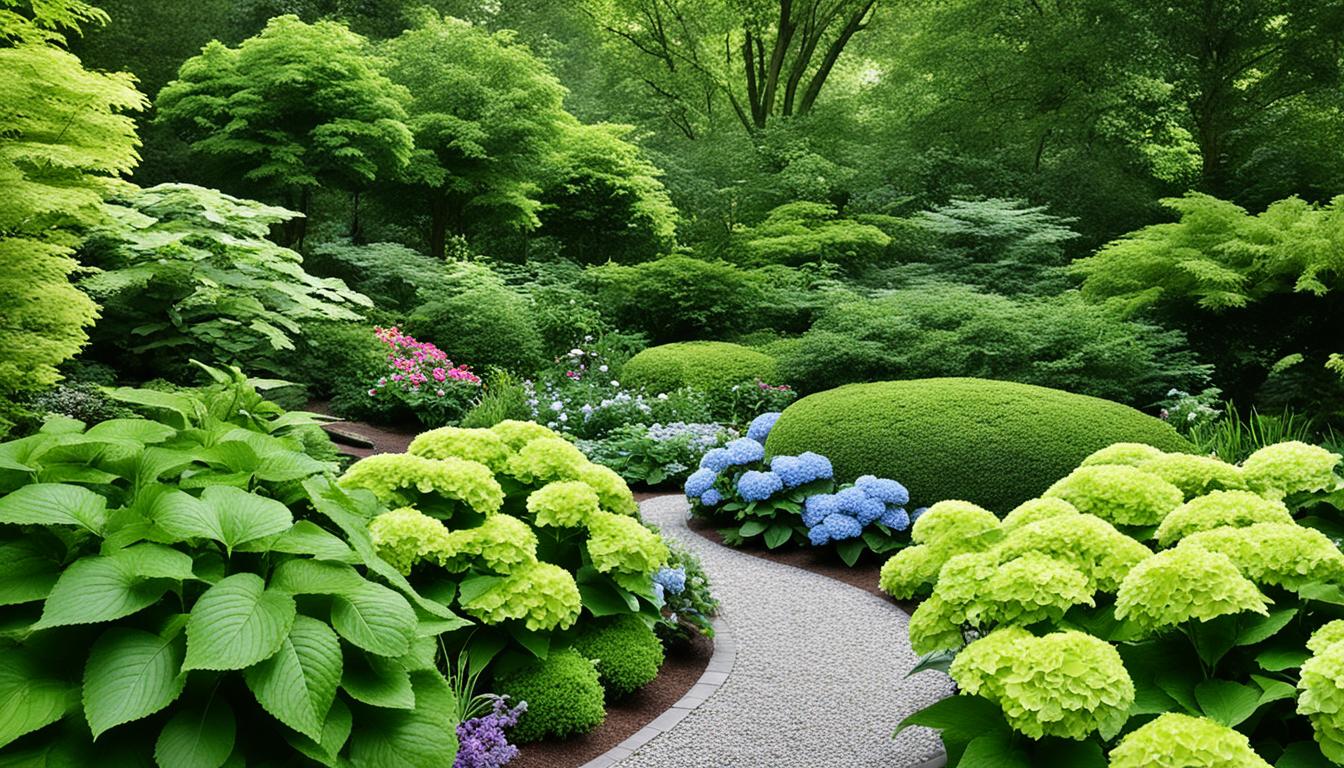
Did you know that the location where you plant your hydrangeas can have a significant impact on their growth and vibrancy? Finding the best place to plant hydrangeas is essential for optimal growth and to ensure that you get the most beautiful blooms.
In this guide, we will explore the different factors to consider when selecting the ideal spot for your hydrangeas. Whether you have a sunny garden or a shady corner, we’ll help you choose the right hydrangea varieties to thrive in various sun and shade conditions. By understanding their sunlight preferences and caring for them properly, you can enjoy vibrant and healthy hydrangea blooms year after year.
Key Takeaways:
- Choosing the right location is crucial for the growth and vibrancy of hydrangeas.
- Hydrangeas can thrive in different sunlight conditions, from full sun to partial shade.
- Consider the specific sunlight needs of different hydrangea varieties for optimal results.
- Proper care, including pruning, fertilizing, and watering, is essential for healthy blooms.
- By following our planting guide and care tips, you can transform your garden with stunning hydrangea displays.
Hydrangeas for Part Shade: Give Us Some Sunblock Please
When it comes to creating the perfect environment for hydrangeas, finding the right balance of sun and shade is key. While some hydrangea varieties thrive in full sun, others prefer a location with partial shade, where they can benefit from the morning sun and enjoy relief from the scorching afternoon rays. These hydrangeas are like beachgoers who know the importance of sunblock, seeking a little shade to protect themselves from the intense heat.
In the family of hydrangeas, there are several popular cultivars that are well-suited for part shade conditions. These varieties have the ability to produce stunning blooms when provided with a combination of filtered light and a few hours of full sun. Among them are the beloved Endless Summer® Hydrangea series, which includes BloomStruck®, Endless Summer®, Blushing Bride®, and Twist-n-Shout®.
Another great choice for morning sun and afternoon shade is the Annabelle Hydrangea, which is known for its spectacular large white flowers. And let’s not forget the many bigleaf hydrangea cultivars that can handle part shade and reward you with their vibrant blossoms.
Here are a few remarkable hydrangea varieties that thrive in part shade:
| Hydrangea Variety | Light Requirements |
|---|---|
| Endless Summer® series (BloomStruck®, Endless Summer®, Blushing Bride®, Twist-n-Shout®) | Morning sun, afternoon shade |
| Annabelle Hydrangea | Morning sun, afternoon shade |
| Bigleaf hydrangea cultivars | Morning sun, afternoon shade |
These hydrangeas have adapted to thrive in part shade by enjoying the gentle morning sun and being sheltered from the intense afternoon heat. This combination of light conditions allows them to produce their enchanting blooms and add a touch of elegance to any garden or landscape.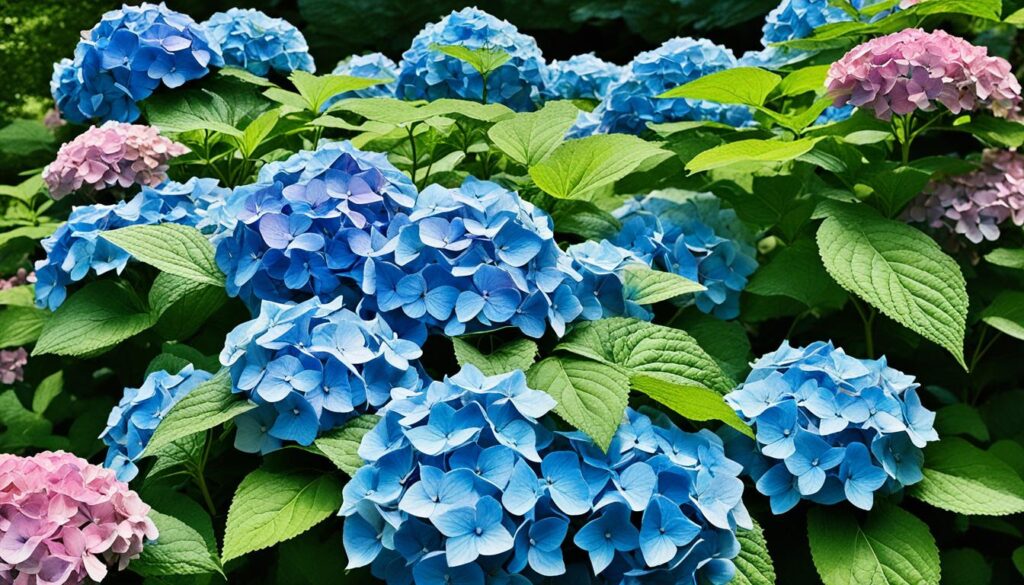
So, if you have a garden or yard with a mix of sunlight and shade, don’t worry! There are plenty of beautiful hydrangeas that will thrive in this environment. Just give them some sunblock (in the form of morning sun) and watch as their blooms light up your space with their breathtaking beauty.
Hydrangeas for Full Sun: We Like It Sunny
While most hydrangeas prefer some shade, there are certain varieties that can thrive in full sun. If your garden gets plenty of sunlight, don’t worry! There are hydrangeas that will flourish in these conditions and reward you with beautiful blooms.
Panicle Hydrangeas
Panicle hydrangeas, known for their cone-shaped flower clusters, are excellent choices for full sun exposure. They can tolerate the direct heat and intense sunlight, making them perfect for sunny spots in your garden. Some popular panicle hydrangeas include:
- Fire Light®
- Limelight
- Pinky Winky®
- Strawberry Sundae®
- Vanilla Strawberry®
Dwarf Varieties
If you have limited space or prefer compact hydrangeas, consider the Let’s Dance® and Cityline® series. These dwarf varieties are perfect for both full sun and part sun environments. They offer the beauty of hydrangeas in a smaller package without compromising on vibrant blooms.
Smooth Hydrangeas
Smooth hydrangeas are another type that can handle full or part sun conditions. These varieties are known for their large rounded flower heads and are a great choice for a sunny garden. Consider the following smooth hydrangeas:
- Incrediball®
- Invincibelle® Ruby
With these hydrangeas, you can enjoy the beauty and charm of these flowering plants even in full sun areas. Just make sure to provide them with proper care and maintenance, including regular watering and occasional fertilization.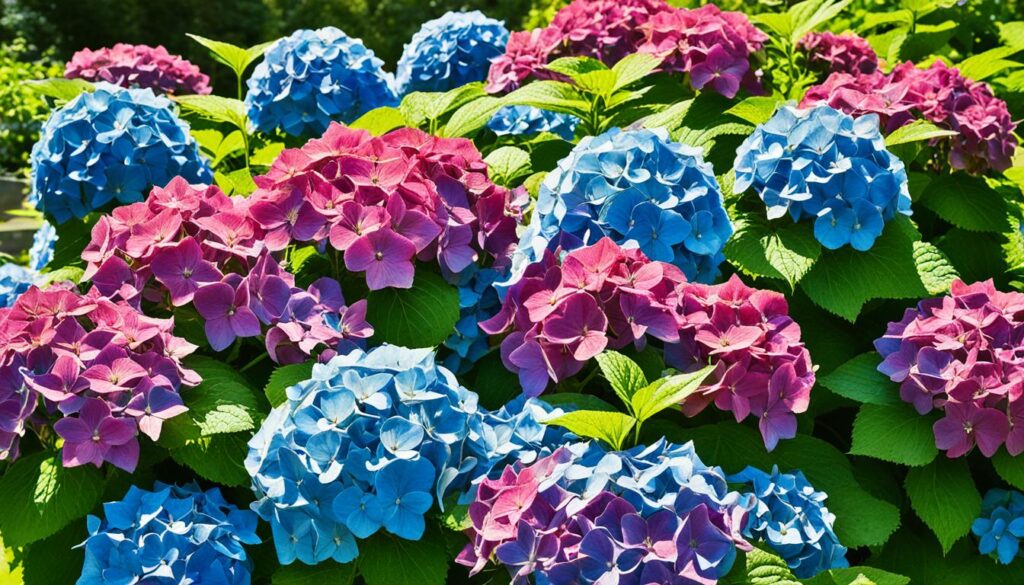
Overall, including hydrangeas that thrive in full sun can add a splash of color and vibrancy to your garden. Whether you choose panicle hydrangeas, dwarf varieties, or smooth hydrangeas, these sun-loving beauties will brighten up any sunny corner of your outdoor space.
Growing Hydrangeas in Different Sun and Shade Conditions
When it comes to growing hydrangeas, understanding their sunlight requirements is essential for their success. While many hydrangea varieties thrive in partial shade, oakleaf hydrangeas are known for their adaptability to different sun and shade conditions.
In the northern parts of the United States, oakleaf hydrangeas can tolerate full sun. However, in warmer and southern climates, they prefer some afternoon shade to protect them from excessive heat and sun exposure. This makes them an excellent choice for those looking to plant hydrangeas in regions with varying temperature and sunlight conditions.
What makes oakleaf hydrangeas unique is their ability to also tolerate full shade. This makes them ideal for areas of the garden that receive little to no direct sunlight. Whether it’s a densely shaded corner or underneath taller trees, oakleaf hydrangeas can thrive and add beauty to areas that are typically challenging for other hydrangea varieties.
It’s important to note that while oakleaf hydrangeas are the most adaptable, other hydrangea varieties have specific sunlight needs. When selecting the location for planting, it’s crucial to consider the specific requirements of each hydrangea type to ensure optimal growth and vigor.
By carefully assessing the sunlight conditions in your garden and selecting the appropriate hydrangea varieties, you can create a diverse and captivating display of hydrangeas that thrive in different sun and shade conditions.
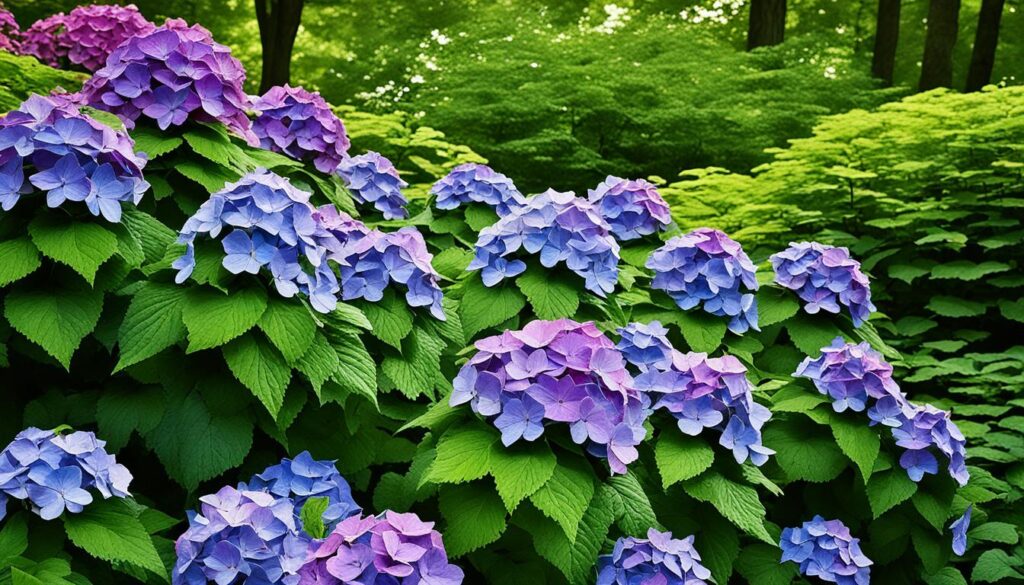
Pruning and Caring for Hydrangeas
Proper pruning and care are essential for the health and vitality of hydrangeas. By implementing appropriate pruning techniques and providing the necessary care, gardeners can ensure the longevity and abundant blooming of their hydrangea plants. Here are some important tips to consider:
Understanding Pruning Methods
When pruning hydrangeas, it’s crucial to understand whether the plant blooms on old wood or new wood. This knowledge will help gardeners avoid accidentally cutting off next season’s flowers.
Tip: Prune hydrangeas that bloom on old wood immediately after flowering. This allows for new growth and development of flower buds for next year. On the other hand, hydrangeas that bloom on new wood can be pruned during late winter or early spring before new growth begins.
Optimal Soil Conditions
Hydrangeas thrive in well-drained soil that is rich in organic matter. A mixture of compost and native soil is ideal for providing the necessary nutrients and moisture retention.
Fertilizing for Healthy Blooms
To promote healthy blooming, it’s recommended to fertilize hydrangeas with a slow-release fertilizer that is high in phosphorus. Phosphorus is essential for promoting flower production and overall plant vitality.
Preventing Leaf Scorch
Hydrangeas are susceptible to leaf scorch, especially during hot and dry periods. To prevent leaf scorch, it’s important to provide hydrangeas with extra water and ensure they have adequate moisture in the soil.
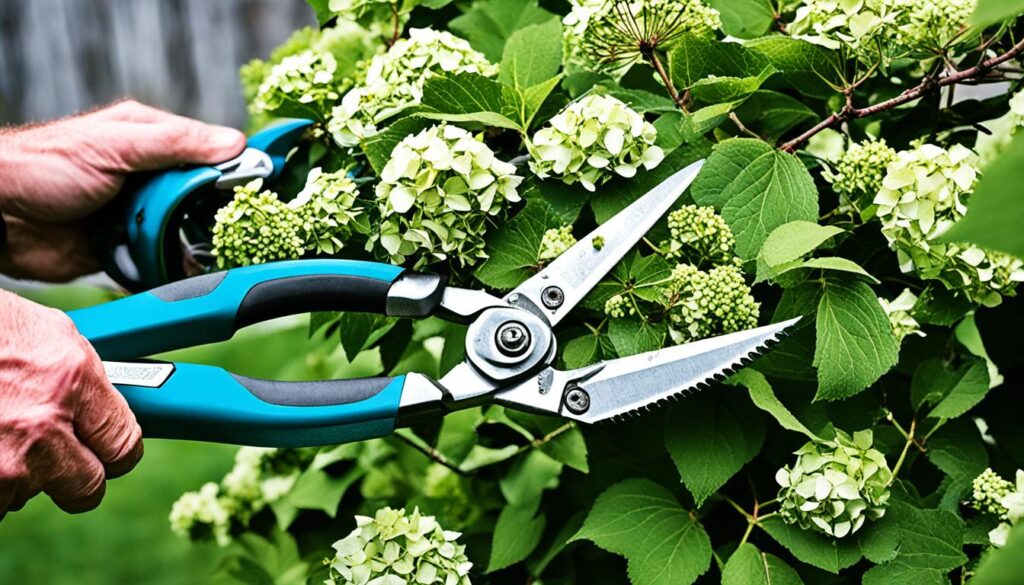
Summary of Pruning and Care Tips
| Pruning Method | Soil Conditions | Fertilizing | Preventing Leaf Scorch |
|---|---|---|---|
| Prune hydrangeas that bloom on old wood immediately after flowering | Well-drained soil with organic compost | Use slow-release fertilizer high in phosphorus | Provide extra water during hot and dry periods |
By following these pruning and care tips, hydrangea enthusiasts can enjoy lush, vibrant blooms year after year. With proper maintenance, these stunning plants will continue to beautify gardens and landscapes.
Conclusion
Planting hydrangeas in the best location and providing proper care and maintenance are key to achieving beautiful and vibrant blooms. By selecting the right spot that balances sun and shade, ensuring well-drained soil, and following recommended pruning and watering practices, gardeners can enjoy the full potential of their hydrangea plants. With the right planting and care, hydrangeas can transform any garden into a colorful and inviting space.FAQ
What is the best place to plant hydrangeas?
What are the best types of hydrangeas for morning sun and afternoon shade?
Can hydrangeas grow in full sun?
Which hydrangea varieties are best for full shade?
How should I prune and care for hydrangeas?
Are there any tips for planting and caring for hydrangeas?
- About the Author
- Latest Posts
Meet Katherine, the creative enthusiast at ByRetreat who infuses her boundless passion for design into every remote workspace she crafts. With an innate sense of creativity and an eye for unconventional beauty, Katherine brings a unique and inspiring perspective to the team.
Katherine’s love for design is infectious, and her ability to think outside the box sets her apart. She believes that true artistry lies in embracing a variety of styles and mixing them harmoniously to create captivating spaces. By combining different textures, colors, and patterns, Katherine weaves a tapestry of creativity that breathes life into each remote workspace.
-

 Decor4 days ago
Decor4 days agoMaximalist Decor Explained: Embrace More Style
-

 Vetted4 weeks ago
Vetted4 weeks ago15 Best Drip Irrigation Systems to Keep Your Garden Thriving
-

 Vetted1 week ago
Vetted1 week ago15 Best Foot Massagers for Neuropathy to Soothe Your Feet and Relieve Discomfort
-

 Vetted2 weeks ago
Vetted2 weeks ago15 Best Sports Laundry Detergents for Keeping Your Activewear Fresh and Clean
-

 Vetted2 weeks ago
Vetted2 weeks ago15 Best Tall Toilets for Seniors That Combine Comfort and Safety
-

 Vetted3 weeks ago
Vetted3 weeks ago15 Best Dish Scrubbers to Keep Your Kitchen Sparkling Clean
-

 Decor3 weeks ago
Decor3 weeks agoWhat Is Eclectic Home Decor
-

 Vetted1 day ago
Vetted1 day ago15 Best Organic Pest Control Solutions for a Naturally Pest-Free Home




















